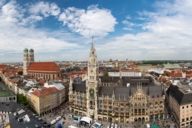
On the weekend of June 14 and 15, 2025, the city of Munich celebrates its 867th birthday under the motto “Splendor, Glory and Enjoyment” and transformes again large parts of Munich's old town into a strolling place that invites visitors to marvel and discover. But how did Munich actually come into being? Here you will find the most important facts and figures about the city's founding.
Information on the city's birthday on June 14 and June 15, 2025 will follow.
The modern Bavarian capital is younger than other Bavarian cities that have Roman heritage, such as Augsburg or Regensburg. In fact its roots can be traced back to the mid-12th century salt trade; back in the Middle Ages it was possible to build a fortune on these familiar white crystals because, before refrigeration arrived, salt was the only way to preserve food. So those in pursuit of political and economic influence were eager to take control of the trade routes, customs stations and shipment hubs that dealt with this precious raw material.
There were three prominent 12th-century rulers involved in the founding of Munich, with various levels of enthusiasm about it: Henry the Lion (Heinrich der Löwe), Duke of Saxony and Bavaria; his cousin and “very best friend” Frederick Barbarossa, Holy Roman Emperor (Kaiser Friedrich Barbarossa); and last but not least Bishop Otto of Freising, one of the leading historians and philosophers of the Middle Ages.
Heinrich is known for being adept at expanding his influence in Bavaria and tapping into new sources of wealth. One of his schemes was to divert the lucrative salt trade away from places such as Bad Reichenhall and Berchtesgaden, by building a bridge (on the site where Deutsches Museum now stands) that would instead bring traders across the Isar river and into his own area of influence. To ensure his success, he also destroyed the existing bridge and adjoining customs post a few kilometres further downriver, which were located in the territory presided over by Bishop Otto of Freising.
Up to that point the Bishop’s bridge had been the only means of crossing the Isar river for miles around. Of course Otto did not submit peacefully to this act of hostility. A dispute ensued and Kaiser Barbarossa stepped in to arbitrate. He passed a ruling known as the Augsburger Einung (Augsburg Unification), in which he essentially approved the actions of his favoured Heinrich – who had, after all, supported the Kaiser in a number of decisive battles – but also compelled the Duke to pay one-third of all his customs revenues to Freising. These payments continued until the start of the 19th century.
The issue date of the Emperor’s ruling – 14 June 1158 – is often considered the birth date of Munich as it is the first time the city’s name is mentioned in an official document. The same document grants the previously insignificant settlement of “Munichen” the right to hold a market and mint its own coins, with the result that it rapidly transformed into an important trading city.
Salt and other goods were traded on Marienplatz, which was still known as Schrannenplatz at that time – this was where the Salt Road towards Augsburg met the northern trade route that led to Italy, after Henry the Lion had rerouted traffic.
Carts accessed the fortified city through Talburgtor (the tower of the Altes Rathaus) and exited it by travelling towards Karlsplatz-Stachus along what is now the Fussgängerzone pedestrian area, and then passing through Kaufingertor (gate), which is no longer standing. Which means the history of the pedestrian area as a thoroughfare goes back more than just half a century – all the way to the city’s early days during the Middle Ages, in fact.
We offer a wide range of city walking tours led by official City of Munich tour guides and suitable for groups or individuals.